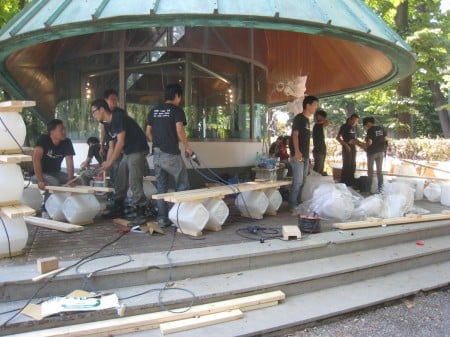
September 9, 2008
A Prologue to Venice
A walkthrough the giardini before next week’s opening of the 2008 Architecture Biennale.
Preparing the U.S. Pavilion for this year’s Architecture Biennale
Photos: Eric Holm
“What’s he building in there? What’s he building in there?”
Tom Waits’ lyrics quickly come to mind during a pre-vernissage stroll through Venice’s Giardini as preparations are made for the 2008 Venice Architecture Biennale. The grounds have come alive with activity as workers are steadily transforming the giardini from an overgrown ghost town into a showcase of contemporary international architecture. Overnight the pavilions of every country, boarded up relics, forgotten representatives, come alive as the plywood is removed, new paint applied, interiors cleaned, and the spiders evicted for workers, students, architects, exhibition designers, translators, curators, and commissioners. The water pools of the Carlo Scarpa garden of the Italian Pavilion have been cleaned of algae; no longer the fertile breeding ground of the menacing tiger mosquito.
Taiwanese students in front of the Stirling bookstore
James Stirling’s green copper roofed bookshop once again houses a fine collection of design books as all the art books of last year’s Biennale of Art are replaced with books representing the various countries, pavilions, and architects. Weeds are replaced with flowers and bushes tamed to resemble a habitable space rather than the jungle they’ve become in the months they’ve been left to lie fallow.
The lutescent Australian Pavilion
The Australian beach house pavilion of Phillip Cox now has a yellow runway with a curled up yellow tongue projecting across its deck that seems to echo the success of the famous “yellow bags” that the Aussies were giving away at last year’s Art Biennale to attract (some would say detract based on the color) people to their pavilion. They definitely stand out for the strangest color choice leading one to wonder if their free swag at the opening will be equally as offensive.
Some pavilions have full-fledged crews constructing installations while others have art handlers carefully unpacking precious architectural models and posters to display under Plexiglas cases. The activity is non stop from morning until evening (rumors are even circulating about the Japanese working until 1am every day) with the only exception being the dead still at 12:30 as the hammers and drills are put down and everyone runs to get food before everything closes at one o’clock.
Without roads in Venice, deliveries work a little differently
Creation of the Japanese Pavilion
At the American Pavilion
Beautifying the grounds
A portion of the Taiwanese installation
Most of all the various pavilions are shrouded in mystery as various workers explore the different sites each wondering what the other country is contributing. The prize for the most alluring (and perhaps confusing) thus far is a tie between the ever-growing follies made of wood, steel, and plastic jugs that several Taiwanese students keep creating and the four glass greenhouses surrounding the Japanese pavilion and the student volunteers that spend their days inside drawing with needlepoint precision on the walls. All that pass by eagerly anticipate how they will all come together.
The Belgian Pavilion is covered in scaffolding —Is it part of the installation experience or is to hide the pavilion until opening day?
Our Biennale blogger, Eric Holm, has worked in architecture and photography and is now perfecting the art of arguing in Italian. Besides leading cicchetti tours beneath the Venetian streetlights, you can find him working at the American Pavilion of the Venice Biennale or you can see his photography at www.eyetone.net.














